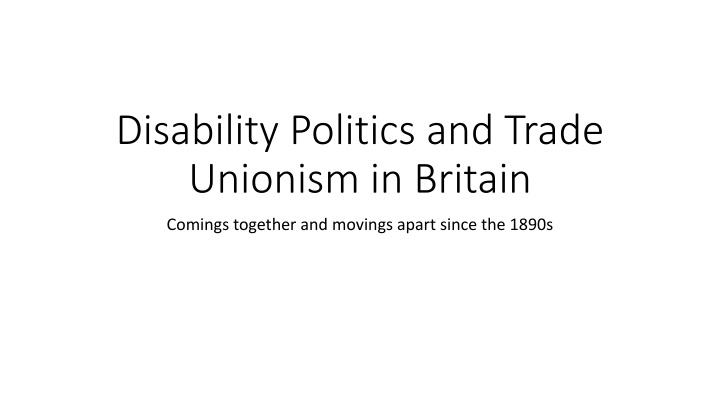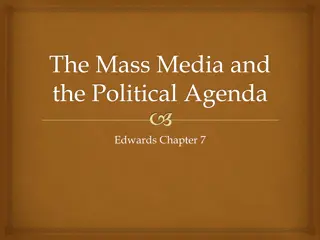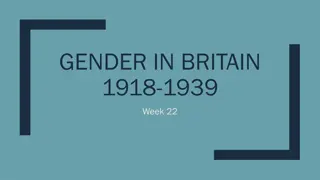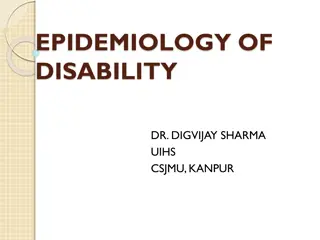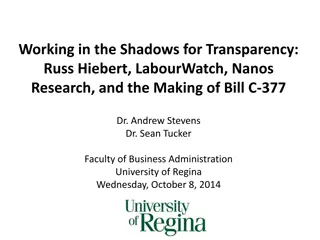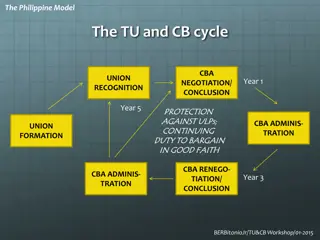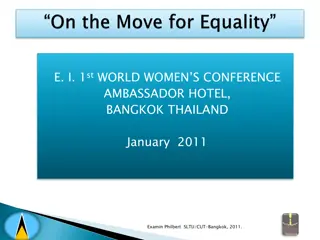Disability Politics and Trade Unionism in Britain: Evolution since the 1890s
The evolution of disability politics and trade unionism in Britain since the 1890s reflects struggles for empowerment, reforms, and societal shifts in perceptions towards disabled individuals. From the establishment of disabled organizations akin to trade unions to the challenges faced in gaining fair treatment, this narrative highlights victories, quiet periods, and the advocacy efforts of disabled activists aiming to secure rights and support from trade unions.
Download Presentation

Please find below an Image/Link to download the presentation.
The content on the website is provided AS IS for your information and personal use only. It may not be sold, licensed, or shared on other websites without obtaining consent from the author.If you encounter any issues during the download, it is possible that the publisher has removed the file from their server.
You are allowed to download the files provided on this website for personal or commercial use, subject to the condition that they are used lawfully. All files are the property of their respective owners.
The content on the website is provided AS IS for your information and personal use only. It may not be sold, licensed, or shared on other websites without obtaining consent from the author.
E N D
Presentation Transcript
Disability Politics and Trade Unionism in Britain Comings together and movings apart since the 1890s
The social definition and work This society is based on the necessity for people to compete in the labour market in order to earn a living. To the employer of labour, the physically impaired are not usually as good a buy as the non-impaired. We therefore end up at or near the bottom of this society as an oppressed group. ( ) When we do succeed in getting employment, our comparatively low productivity means that we have low bargaining-power when it comes to negotiating decent treatment and facilities. Our position is similar to that of many people who are middle-aged or elderly, who have had break- downs, or are mentally handicapped , black, ex-prisoners, unskilled workers, etc. We are usually among the first to lose our jobs and be cast on the scrap-heap when it suits the needs of the economy. If we are lucky we may be drawn in again, to do the worst paid work, when business starts to boom once more. If we are unlucky, then we could face a lifetime on the degrading, means-tested poverty line. If we are very unlucky we may be consigned to a soul-destroying institution UPIAS (1975)
Disability politics and New Unionism 1890- 1920 Two organisations of disabled people, in the tradition of trade unionism, were founded in the 1890s: The National League of the Blind, and the National Union of the Deaf. The NLB organised blind workers in segregated workshops, and blind artisans and repair workers, primarily in the North West and Midlands. Fights for better pay and conditions were combined with attempts to remove charities from their central role in blind people s lives The NUD first organised Deaf teachers and sympathetic parents/workers to fight for language rights within schools. As time went on, the NUD became a mutual aid and cultural body on one hand, and a collective bargaining body in some local factories on the other
Victories and the quiet period (1920-1965) Both the NLB and the NUD won meaningful reforms. The NUD secured education policy changes around sign language and school admissions in the 1910s, and the NLB won the Blind Person s Act in 1921 which defined state support for blind workers, loosening the grip of charities over their lives. Because both unions were single impairment, and so many disabled people were unemployed, trade union support for disabled people s liberation petered out. The lives of people excluded from work entirely because of an impairment (except veterans) were left to the responsibility of hospitals, charities, and supplementary benefit (read Poor Law) boards
The late 60s: or, why nothing is simple In the late 60s it became clear that the welfare state was not working for the majority of disabled people. Disabled activists, aware that Trade Union struggle was the motor of social change, began appealing directly to the trade unions or modelling their activism on union strategy. In London, Dorothy and Marsh Dickson launched a campaign for state funded Personal Assistants. After making their case to trade unionists affiliated to the Labour Party, a right to care at home was voted into Party policy in 1966 In Le Court Care Home in Hampshire, residents used the example of the works council to argue for joint management of the home by workers, bosses, and the people who lived there. After mobilising residents, some workers, and people who donated to the home, this was granted in 1966
1960s: cont. Successes and failures These alliances were successful, but only up to a point. Harold Wilson s government ignored party policy, and refused to mandate councils to provide PAs. After pressure from the TUC, they eventually provided cash benefits to some disabled people to employ their own carers, and allowed a back-bencher s Bill to pass which allowed councils to provide home carers if they wanted to. The model of joint management failed to spread in care homes partly due to staff intransigence
The Long Crisis onwards In the 1970s, disabled people continued to emulate the tactics, rhetoric and concerns of trade unionists; building a militant mass movement and demanding a say over national policy. As the economic crisis deepened, however, the trade union movement became less and less interested in issues facing non-workers; and more concerned to protect it s existing agreements with employers and government. As the 80s and 90s went on, the relationship between trade unionism and disability politics became more dispersed and occasional. Trade unionists saw disability as a matter for government policy, and disabled activists became more concerned with individual rights than collective ownership and management of the economy and state.
Limitations of Trade Union involvement in disability politics Membership organisations struggle to represent people who can t be members even if they would like to Anti-trade union laws make this even more difficult narrowing remits of what unions are allowed to do There remains a certain paternalism (Williams-Findlay) in much of the labour movement disability and social questions are for the state and the charities, not working class militancy Acute problems exist in specific workplaces: are disabled people s interests in a care home the same as the union branch s?
Limitations of the DPM on working class politics Major bodies began to see rights (including at work) as individual, rather than collective. Policies or statutes against discrimination and inequality became more important than transforming work from the ground up. The Tories turn to consumerism in welfare in the 90s offered (short lived) benefits to many disabled people, while screwing workers. Taking advantage of this made it difficult to work together in many cases. Disability issues at work were often taken less seriously than consumer rights, access to infrastructure, or care services
Where we are Both the labour and disabled people s movement are coming back from a low ebb The pandemic has thrown many workers and many disabled people into desperate situations, but has given opportunities for our organisations to show their muscle. Fiscal responses to the pandemic may encourage exploitation and austerity. The political climate is increasingly authoritarian. Both are major threats to our resurgent movements. More workers are coming out as having an impairment or condition that clashes with their working conditions. Others get impairments or conditions through their work, including a rising number in growing industries. We don t yet know the level or impairment related to long covid, nor how employers will respond to it in the long-term
Where are we going? That s up to us Alliances between Unions and the DPM can t just be rhetorical, or they fall apart. Where our interests as trade unionists and our interests as disabled people diverge, we need to have honest conversations about that. We can t compartmentalise social problems the way work is organised affects workers and non-workers; care services are things many workers will need; punitive welfare models dehumanise disabled claimants and administrators We are faced with real risks and real opportunities, how we approach them now will set the stage for the following decades
In this sense, then, I believe that we cannot understand or deal with disability without dealing with the essential nature of society itself. To do this disabled people must find ways of engaging in the class struggle where the historical direction of society is fought, won or lost. It is in this arena that the boundaries of knowledge that have put disabled people aside from the normal can and have to be openly questioned. For me repossessing the social model of disability means searching for openings in the structures of society where we might effectively contribute with others in the restructuring of society so that it is neither competitive nor disabling for all people Vic Finkelstein: 2001
